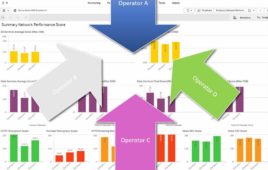Did you know that social apps are used more often on lower-end phones, while productivity apps are accessed more frequently on higher-end models? Or that the vast majority of smartphones in Asia (71 percent) and the Middle East and Africa continue to be configured with English? Or that Americans aren’t as addicted to Wi-Fi as they appear, spending only about half of their time on Wi-Fi, the rest on cellular networks? What about the fact that most people use their mobile phones a lot less during the weekends than during the weekdays?
A recent study applied advanced analytics to a wealth of end-user interaction data on Android devices, revealing some very interesting findings on how users around the world use their phones – what types of apps; on what types of devices; in what languages; and on what types of networks (Wi-Fi or cellular). These insights represent the beginning of the next frontier that companies across the entire mobile ecosystem – device manufacturers, mobile operators and application developers – can leverage to make smarter, more strategic business decisions.
End-user device interaction data is a digital goldmine that can help companies understand their customer behavior at an unparalleled level. It is a key asset, much needed in the hyper-competitive mobile landscape where users tend to have shorter attention span and relevance is paramount. Yet, many mobile companies still struggle to be capable of deriving value from this data. Though these companies have handled large amounts of data for years, end-user device interaction data can be a true game-changer for those that successfully take advantage of it.
History
Smartphone users, by default, provide a lot of information on their likes and dislikes, engagement patterns and more, just from the way they use their device. Typically, only Google and Apple have had true access to this data. Companies such as Google have benefited richly by utilizing it to refine their ad platforms for better targeting. However outside of Google, very few companies have had the ability to get access to this valuable data set.
This paradigm is starting to change. By combining rich end-user device interaction data with advanced analytics, actionable information on end users is starting to emerge. Much like other industries, data analytics can deliver major competitive advantages. For example:
Device manufacturers: Design of newer devices by most manufacturers lacks a strong understanding of usage patterns in various markets, resulting in hits and misses that could turn out to be quite expensive. Device manufacturers can truly tailor and segment their products if they get a better understanding of how end-users utilize their devices. Is the most common use case downloading music? Accessing social media? Visiting news sites? Which devices do people use most, and for what? Based on this information, device manufacturers can better tailor their next generation of devices to suit these niches, as well as carve out a unique brand identity that engenders brand loyalty. This segregation of the Android market into specialized niches was long predicted, and remains the best hope for smaller brands. The right mixture of features at the right price point will eventually aid manufacturers in creating devices that appeal most to their target user base.
Similarly, the earlier referenced study showed a clear correlation between high-end handsets and frequent use of productivity applications and business-oriented social networks like LinkedIn. This type of data can help handset manufacturers decide what types of capabilities they should include in their products. For example, Samsung handsets include a note-taking application complete with cloud-based synchronization (S Note), and while it might not be as feature-rich as Evernote it clearly suffices for many users. This is a great example or product specialization for a high-end device manufacturer.
Developers: This group also stands to gain critical intelligence from end-user interaction data. Developers offering apps specifically designed for use on Wi-Fi – Whatsapp or Vibr, for example – can determine which global regions should be the highest priority, based in large part on Wi-Fi usage trends. Or, a developer may identify which language support is the highest priority in the geographies they are targeting.
Operators: Finally, a wealth of end-user interaction data can help operators understand, differentiate and target their services better to their subscribers, based on usage trends. For example, an operator may analyze customers’ location and travel patterns, and determine which end-user segments are the best targets for promoting data roaming services. Even though this data has been available to operators for a long time, the easiness of accessing and utilizing the data to run the right campaigns to the user base has been missing. Going even a step further, an operator can determine which marketing vehicles are most effective in reaching these end users (perhaps social), which is another fortunate by-product of analyzing end-user interaction data.
By adopting a data-driven and precisely targeted approach to customer outreach, operators in particular can improve customer acquisition as well as retention by improving overall customer satisfaction. Such targeted marketing strategies can significantly reduce churn and improve company perception
Companies across the mobile spectrum are competing for cost-conscious customers demanding highly personalized mobile experiences and interactions. Customer attention span is also continuously dropping, making it essential to target them with the right messages, at the right time.
To compete, thrive and sometimes survive, mobile device manufacturers, operators and developers need to leverage every opportunity they can to tailor their offerings and attract customers. Increasingly, end-user device interaction data holds many clues as to what customers want, and henceforth, what strategies will drive revenues. Google may hold the keys to the kingdom, particularly when it comes to Android app usage. But there are other ways to gain access to parts of this kingdom, and combining end-user device interaction data with advanced analytics is an emerging ace in the hole.
Ramgopal “Anand” Vidyanand is Vice President of Corporate Marketing and Business Development at mobile marketing company Celltick.




